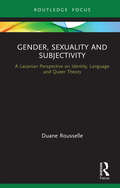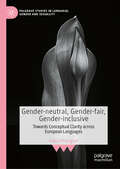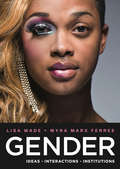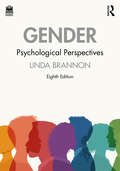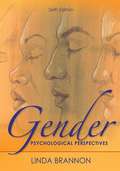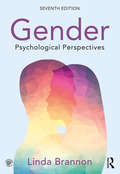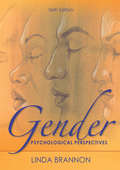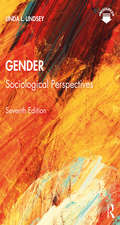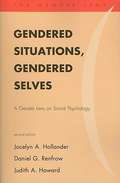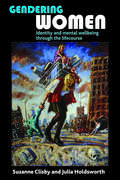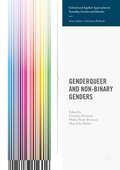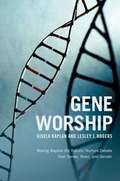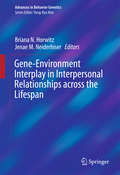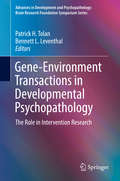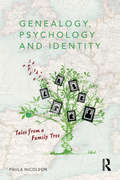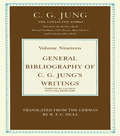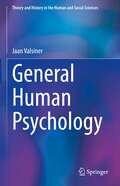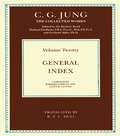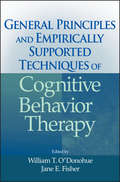- Table View
- List View
Gender, Sex and Sexuality: Contemporary Psychological Perspectives (Contemporary Psychology Ser.)
by Gerda SiannFor some time sex has been defined as the biological difference between men and women, and gender as the manner in which culture defines and constrains these differences. Feminine/masculine, male/female, women/men, boy/girl - terms of sexual and gender division like these permeate the way we think and talk about ourselves and each other. On most occasions we find their use non-problematic and people employ them easily, at other times, however, particularly if we are interested in psychology, we may wonder whether this ease is illusory.; One may speculate whether being a woman necessarily implies being "feminine". One may question why young women are often referred to as girls, while men are seldom referred to as boys. Is dressing in a stereotypically feminine manner a reliable indication that a woman is heterosexual? What about cross dressing? Why do these topics hold so much fascination for the media?; "Gender, Sex and Sexuality" examines the effects that the inequalities experienced between men and women have had on the psychologies of both sexes, and the battle to remove them. It aims to introduce the reader to current research and theories, drawing on novels, theatre, soap operas, as well as research for case histories.
Gender, Sexuality and Subjectivity: A Lacanian Perspective on Identity, Language and Queer Theory (Routledge Focus on Mental Health)
by Duane RousselleOffering a concise yet comprehensive introduction to gender theory, this thought-provoking new book aims to make an intervention into the contemporary American paradigm of thinking gender and sexuality and offers a powerful challenge to the paradigm of social constructionism. Within each gender paradigm there are unacknowledged truths. The controversial claim of this book is that queer theory and intersectionality – and, more broadly, the social constructionist paradigm – have reached a limit. Indeed, it is possible that they are becoming regressive political gestures. However, there are possibilities of moving forward in this new area of transformation and Rousselle claims that a new logic of gender invention is opening up a new paradigm of thought. Part of the popular Routledge Focus on Mental Health series, this book will be of immense value to students and teachers who aim to understand in a basic way some of the various main paradigms, theories, and concepts within gender and sexuality studies. It will also be an important attempt to think beyond those paradigms and theories.
Gender-based Violence and Depression in Women
by Deborah WesternSocial workers, in whatever capacity they work, can expect to come into contact with women who have experienced/are experiencing violence and with women who are experiencing depression. Therefore, a range of social work supports and interventions are required in order to meet the needs of diverse women and assist them in their recovery. One of these methods is group work where women can share their experiences, learn from each other, reflect on their learnings and identify and achieve changes in their circumstances. This book is based on original research by the author that sought to understand depression in women from a feminist and gender-informed perspective, develop a feminist-based group work response, and highlight the activities of consciousness-raising and resistance as methods for women to achieve change in their lives and in their selves. An innovative and creative group work program, the Women's Journaling Group Program, was developed from this research and provides a new method of working with women who have experienced/are experiencing violence and mild-moderate depression. The Women's Journaling Group Program is research-informed, theoretically-grounded, practice-based and feminist and gender-focused. This book, and the program model within it, is an important contribution to the field of critical feminist social work practice.
Gender-neutral, Gender-fair, Gender-inclusive: Towards Conceptual Clarity across European Languages (Palgrave Studies in Language, Gender and Sexuality)
by Falco PfalzgrafThis edited book explores the ambiguity and overlap in the usage of terms such as &“gender-inclusive&”, &“gender-fair&”, and &“gender-neutral&” across various disciplines and languages, aiming to achieve conceptual clarity and advocate for standardisation. The authors examine different aspects of gender-inclusivity in European languages including Dutch, English, French, German, Italian, Polish, Romanian, Spanish, and Swedish. This book will be of interest to students and scholars of fields such as Linguistics, Psychology, Anthropology, and Cultural Studies.
Gender: Ideas, Interactions, Institutions
by Myra Marx Ferree Lisa WadeA lively exploration of current questions of gender and their application to students today. Wade and Ferree's first edition textbook is a lively introduction to the sociology of gender. Probing questions, the same ones that students often bring to the course, frame readable chapters that are packed with the most up-to-date scholarship available--in language students will understand. The authors use memorable examples mined from pop culture, history, psychology, biology, and everyday life to truly engage students in the study of gender and spark interest in sociological perspectives.
Gender: Psychological Perspectives
by Linda BrannonThis fully updated and revised eighth edition examines the behavioral, biological, and social context in which people express gendered behaviors, utilizing the latest research to help students think critically about research findings and stereotypes and provoking them to examine and revise their own preconceptions.The text’s unique pedagogical program helps students understand the portrayal of gender in the media and the application of gender research in the real world. Headlines from the news open each chapter; Gendered Voices present true personal accounts of people’s lives; According to the Media boxes highlight gender-related coverage in newspapers, magazines, books, TV, and movies; while According to the Research boxes offer the latest scientifically based research to help students analyze the accuracy and fairness of gender images presented in the media. Additionally, Considering Diversity sections emphasize the cross-cultural perspective of gender.Key features of the new edition include Expanded discussion of transgender and non-binary identities 12 new headline articles including topics ranging from the myth of biological sex to the wars over sex education and the factors involved in the gender pay gap Comprehensive digital resources with content for instructors and students. Intended for undergraduate or graduate courses on the psychology of gender, psychology of sex, gender issues, women in society, and women’s or men’s studies, this book is also applicable to sociology and anthropology courses on diversity.
Gender: Psychological Perspectives (6th Edition)
by Linda BrannonThis book examines the topic of gender--the behaviors and attitudes that relate to (but are not entirely congruent with) biological sex.
Gender: Psychological Perspectives, Seventh Edition
by Linda BrannonGender: Psychological Perspectives synthesizes the latest research on gender to help students think critically about the differences between research findings and stereotypes, provoking them to examine and revise their own preconceptions. The text examines the behavioral, biological, and social context in which women and men express gendered behaviors. The text’s unique pedagogical program helps students understand the portrayal of gender in the media and the application of gender research in the real world. Headlines from the news open each chapter to engage the reader. Gendered Voices present true personal accounts of people's lives. According to the Media boxes highlight gender-related coverage in newspapers, magazines, books, TV, and movies, while According to the Research boxes offer the latest scientifically based research to help students analyze the accuracy and fairness of gender images presented in the media. Additionally, Considering Diversity sections emphasize the cross-cultural perspective of gender. This text is intended for undergraduate or graduate courses on the psychology of gender, psychology of sex, psychology of women or men, gender issues, sex roles, women in society, and women’s or men’s studies. It is also applicable to sociology and anthropology courses on diversity. Seventh Edition Highlights: 12 new headlines on topics ranging from gender and the Flynn effect to gender stereotyping that affects men Coverage of gender issues in aging adults and transgendered individuals Expanded coverage of diversity issues in the US and around the globe, including the latest research from China, Japan, and Europe More tables, figures, and photos to provide summaries of text in an easy-to-absorb format End-of-chapter summaries and glossary Suggested readings for further exploration of chapter topics Companion website at www.routledge.com/cw/Brannon containing both instructor and student resources
Gender: Psychological Perspectives, Sixth Edition
by Linda BrannonThis bestselling text presents research about gender and helps students think critically about the differences between research findings and gender stereotypes. It examines the biology and social context in which women and men express gendered behaviors. Defining gender as the behaviors and attitudes that relate to (but are not entirely congruent with) biological sex, the book focuses on research and scholarship to provide the material for a critical review and an overall picture of gender from a psychological perspective. To highlight how research findings can relate to people's lives, the book supplements the review of scholarly research with personal, narrative accounts of gender-relevant aspects of people's lives. To emphasize the cross-cultural perspective of gender, the book including a section on diversity in most chapters but also weaves diversity issues throughout the text. The personal narrative and diversity highlights help to balance the research-based scholarship with the personal experience of gender.
Gender: Sociological Perspectives
by Linda L. LindseyA landmark publication in the social sciences, Linda Lindsey’s Gender is the most comprehensive textbook to explore gender sociologically, as a critical and fundamental dimension of a person’s identity, interactions, development, and role and status in society. Ranging in scope from the everyday lived experiences of individuals to the complex patterns and structures of gender that are produced by institutions in our global society, the book reveals how understandings of gender vary across time and place and shift along the intersecting lines of race, ethnicity, culture, sexuality, class and religion. Arriving at a time of enormous social change, the new, seventh edition extends its rigorous, theoretical approach to reflect on recent events and issues with insights that challenge conventional thought about the gender binary and the stereotypes that result. Recent and emerging topics that are investigated include the #MeToo and LGBTQ-rights movements, political misogyny in the Trump era, norms of masculinity, marriage and family formation, resurgent feminist activism and praxis, the gendered workplace, and profound consequences of neoliberal globalization. Enriching its sociological approach with interdisciplinary insight from feminist, biological, psychological, historical, and anthropological perspectives, the new edition of Gender provides a balanced and broad approach with readable, dynamic content that furthers student understanding, both of the importance of gender and how it shapes individual trajectories and social processes in the U.S. and across the globe.
Gendered Norms at Work: New Perspectives on Work Environment and Health (Aligning Perspectives on Health, Safety and Well-Being)
by Britt-Inger Keisu Susanne Tafvelin Helene BrodinThis edited volume discusses how deeply entrenched gender norms in work environments, even in welfare economies, can affect women’s health in an adverse way. The volume provides a broad overview of contributing factors. It derives specific answers from case studies in Sweden, a welfare state where women’s labour market participation is very high, but where horizontal and vertical gender segregation in work is also one of the highest in the world. Women tend to work in occupations that are heavily dominated by women. An issue in women-dominated occupations is a considerably higher sickness absence than men, with the highest rates being in human service and care occupations. This volume adds to the literature on health and wellbeing in women-dominated professions and workplaces through studying the work environment, organizational changes, digitalization, threats, violence and conflict, and work conditions that could contribute to healthier workplaces for women. In addition, it points to the need for deeper gender analysis in work norms, and using both quantitative and qualitative approaches. It is of interest to social and behavioural scientists studying work, gender and health, as well as HR professionals and policy makers.
Gendered Situations, Gendered Selves: A Gender Lens on Social Psychology (Second Edition)
by Judith A. Howard Jocelyn A. Hollander Daniel G. RenfrowThe book examines the basic underpinnings of everyday interaction: from how we think, to who we see ourselves and others to be, to how we interact with others. Each of these processes is based on both social psychology and gender (as differentiated from sex), as well as our racial backgrounds, ethnic heritages, socioeconomic circumstances, sexualities, and national histories. The authors present and critique each of the major theories of social psychology, social exchange, social cognition, and symbolic interaction. In doing so, the book introduces a full array of key concepts in social psychology—perception, stereotyping, attribution, self-presentation, impression management, defining social situations, exchanging resources, and balancing power and dependence in social relations. The book also discusses two fundamental aspects of human behavior—the dynamics of helping and harming. The second edition incorporates discussions of contemporary psychological and sociological research and features powerful new examples, including 9/11 and the election of Barack Obama.
Gendering Addiction
by Nancy D. Campbell Elizabeth EttorreThis study, by two leading scholars in the field, draws on feminist theory and science and technology studies to uncover a basic injustice for the human rights of drug-using women: most women who need drug treatment in the US and UK do not get it. Why not?
Gendering Women: Identity and Mental Wellbeing through the Lifecourse
by Suzanne Clisby Julia HoldsworthAvailable Open Access under CC-BY-NC-ND licence Gendering Women is an engaging and accessible account of how constructions of femininity fundamentally affect women's mental wellbeing through the life course. Led by women’s life history accounts of growing up and growing older in the north of England, this book shows how experiences of becoming and being a woman – in family life, education, employment, motherhood and situations of violence – both enable and erode self confidence and esteem. The challenges to women’s mental wellbeing cut across age and class differences and have profound impacts on the material conditions of women’s lives throughout the life course. This is in turn a driver of inequality that is often under-recognised in mainstream policy. Based on feminist and ethnographically informed research with over five hundred women Gendering women provides a critical link between gender theory and the lived realities of women’s daily lives and will appeal to students and academics in sociology and social sciences.
Genderqueer and Non-Binary Genders
by Christina Richards Meg-John Barker Walter Pierre BoumanThis book addresses the emerging field of genderqueer or non-binary genders - that is, individuals who do not identify as male or female. It considers theoretical, research, practice, and activist perspectives; and outlines a basis for good practice when working with non-binary individuals. The first section provides an overview of historical, legal and academic aspects of this phenomenon. The second section explores how psychotherapeutic, psychological and psychiatric theory and practice are adapting to a non-binary model of gender, and the third section considers the body related aspects, from endocrinology to surgery. This work will appeal to a wide readership, from practitioners working with non-binary individuals - including psychologists, surgeons, social workers, nurses, psychiatrists, endocrinologists, psychotherapists and counselors, lawyers, and healthcare workers - to researchers interested in the study of gender identities, to students and gender activists.
Gene Worship: Moving Beyond the Nature/Nurture Debate over Genes, Brain, and Gender
by Gisela Kaplan Lesley J. RogersPLANGISE|GENEWORSHIPMOVI
Gene-Environment Interactions in Developmental Psychopathology
by Michael Rutter Kenneth DodgeBringing together foremost experts, this book reviews groundbreaking gene-environment research and explores implications for clinical practice, prevention, and public policy. Presented is cutting-edge work on the interplay of genetic factors and childhood experiences in the development of mental disorders such as depression, conduct disorder, and schizophrenia. Essential topics include what scientists currently know about "susceptibility genes"; the mechanisms by which maltreatment and other stressors interact with biological susceptibilities across development; and factors that make certain children more resilient than others. Future directions for personalizing treatment and prevention efforts, thus making them more effective, are discussed.
Gene-Environment Interplay in Interpersonal Relationships across the Lifespan
by Briana N. Horwitz Jenae M. NeiderhiserIntriguing new findings on how genes and environments work together through different stages of life take the spotlight in this significant collection. Studies from infancy to late adulthood show both forces as shaping individuals' relationships within family and non-family contexts, and examine how these relationships, in turn, continue to shape the individual. Transitional periods, in which individuals become more autonomous and relationships and personal identities become more complicated, receive special emphasis. In addition, chapters shed light on the extent to which the quantity and quality of genetic and environmental influence may shift across and even within life stages. Included in the coverage: Gene-environment interplay in parenting young children. The sibling relationship as a source of shared environment. Gene-environment transactions in childhood and adolescent problematic peer relationships. Toward a developmentally sensitive and genetically informed perspective on popularity. Spouse, parent, and co-worker: roles and relationships in adulthood. The family system as a unit of clinical care: the role of genetic systems. Behavioral geneticists, clinical psychologists, and family therapists will find in Gene-Environment Interplay in Interpersonal Relationships across the Lifespan a window into current thinking on the subject, new perspectives for understanding clients and cases, and ideas for further study.
Gene-Environment Transactions in Developmental Psychopathology
by Patrick H. Tolan Bennett L. LeventhalThis book examines the current research in gene-environment transactions (GEX) and its potential use in developing interventions and applications tailored to individual genetic makeups. Key concepts underlying GEX studies in this area are defined, identifying fundamental challenges in devising informed research questions and conducting valid and useful experiments. Chapters analyze GEX models inspired by the present day genome-based frameworks, particularly in terms of advances in identifying and understanding complex environmental factors, using examples from common psychological conditions, such as antisocial behavior, chronic physical aggression, and chronic internalizing disorder. In addition, the book presents new and potential applications of the framework in the contexts of prevention science and intervention research. Topics featured in this book include: Epigenetics and the biology of gene x environment interactions. Gene by environment interactions and its potential use for intervention strategies in anxiety disorders. The challenges and potential for research on gene-environment interactions within autism spectrum disorder. Using genetically informed prevention trials to test gene x environment hypothese. Challenges for intervention research within the GEX framework. Gene-Environment Transactions in Developmental Psychopathology is a must-have resource for researchers/professors, clinicians, and related professionals as well as graduate students in developmental psychology, psychiatry, human genetics, and related disciplines.
Genealogy, Psychology and Identity: Tales from a family tree
by Paula NicolsonThe popularity of amateur genealogy and family history has soared in recent times. Genealogy, Psychology and Identity explores this popular international pastime and offers reasons why it informs our sense of who we are, and our place in both contemporary culture and historical context. We will never know any of the people we discover from our histories in person, but for several reasons we recognize that their lives shaped ours. Paula Nicolson draws on her experiences tracing her own family history to show how people can connect with archival material, using documents and texts to expand their knowledge and understanding of the psychosocial experiences of their ancestors. Key approaches to identity and relationships lend clues to our own lives but also to what psychosocial factors run across generations. Attachment and abandonment, trusting, being let down, becoming independent, migration, health and money, all resonate with the psychological experiences that define the outlooks, personalities and the ways that those who came before us related to others. Nicolson highlights the importance of genealogy in the development of identity and the therapeutic potential of family history in cultivating well-being that will be of interest to those researching their own family tree, genealogists and counsellors, as well as students and researchers in social psychology and social history.
Genealogy, Psychology and Therapy: Uncovering Trauma
by Paula NicolsonFully revised and updated, Genealogy, Psychology and Therapy highlights the importance of genealogy in the development of identity, and the therapeutic potential of family history in cultivating wellbeing. The popularity of amateur genealogy and family history has soared in recent times. We will never know any of the people we discover from our histories in person, but for several reasons, we recognize that their lives shaped ours. Key approaches to identity and relationships lend clues to our own lives but also to what psychosocial factors run across generations. Attachment and abandonment, trusting, being let down, becoming independent, migration, health and money, all resonate with the psychological experiences that define the outlooks, personalities and the ways that those who came before us related to others. This new edition builds on the original book, Genealogy, Psychology, and Identity, by highlighting the work of Erik Erikson along with studies of the quality of attachment, historical social conditions especially war, forced migration, health inequalities and financial uncertainty, to enable a more detailed understanding of trauma and its long shadow, and to focus on how genealogy informs our identities and emotional health status, exploring the transmission of trauma across generations. The intergenerational transmission of trauma is examined using analysis of real-life family examples, alongside an assessment of a narrative therapy approach to healing. The book expands on how psychological practices together with genealogical evidence may impart resilience and emotional repair, and develops the discussion of the psychological methods by which we interconnect in a reflective way with material from archival databases, family stories and photographs and other sources including DNA. Showing how people can connect with archival material, using documents and texts to expand their knowledge and understanding of the psychosocial experiences of their ancestors, this book will be of interest to those researching their own family tree, genealogists and counsellors, as well as students and researchers in social psychology and social history.
General Bibliography of C.G. Jung's Writings (Collected Works of C. G. Jung)
by C.G. JungThis bibliography records the initial publication of each original work by C.G. Jung, each translation, and significant revisions and expansions of both, up to 1975. In nearly every case, the compilers have examined the publications in German, French and English. Translations are recorded in Danish, Dutch, English, Finnish, French, Greek Hebrew, Hungarian, Italian, Japanese, Norwegian, Portuguese, Russian, Serbo-Croatian, Slovenian, Spanish, Swedish and Turkish. It is arranged according to language, with German and English first, publications being listed chronologically in each language. The General Bibliography lists the contents of the respective volumes of the Collected Works (of which this is Volume 19) and the Gesammelte Werke, published in Switzerland, and shows the interrelation of the two editions. It also lists Jung's seminars and provides, where possible, information about the origin of works that were first conceived as lectures. An index is provided of all the titles in English and German, and all original works in the other languages. Three specialist indexes, of personal names, organizations and societies and periodicals, complete the work. The publication of the General Bibliography, together with the General Index (Volume 20 of the Collected Works), complete the publication of the Collected Works of C.G. Jung in English.
General Human Psychology (Theory and History in the Human and Social Sciences)
by Jaan ValsinerThe book includes a new theoretical synthesis of William Stern’s classic personology published in the 1930s with contemporary cultural psychology of semiotic mediation developed by the author over the last two decades. It looks at the human mind as it operates in its full complexity, starting from the most complex general levels of aesthetic and political participation in society and ending with individual willful actions in everyday life contexts.
General Index (Collected Works of C.G. Jung)
by C.G. JungThis volume is the general index to the eighteen published textual volumes in the Collected Works of C.G. Jung. The comprehensive indexing goes beyond the volume indexes, and includes sub-indexes to important general topics, such as Alchemical Collections, Codices and Manuscripts, Feud and Numbers, the sub-indexing for the Bible arranged by book, chapter and verse. The General Index, with the General Bibliography of C.G. Jung's Writings (Volume 19 of the Collected Works), together complete the publication of the Collected Works of C.G. Jung in English.
General Principles and Empirically Supported Techniques of Cognitive Behavior Therapy
by William T. Fisher Jane E. O'DonohueProven and effective, cognitive-behavior therapy is the most widely taught psychotherapeutic technique. General Principles and Empirically Supported Techniques of Cognitive Behavior Therapy provides students with a complete introduction to CBT. It includes over 60 chapters on individual therapies for a wide range of presenting problems, such as smoking cessation, stress management, and classroom management. Each chapter contains a table clearly explaining the steps of implementing each therapy. Written for graduate psychology students, it includes new chapters on imaginal exposure and techniques for treating the seriously mentally ill.

